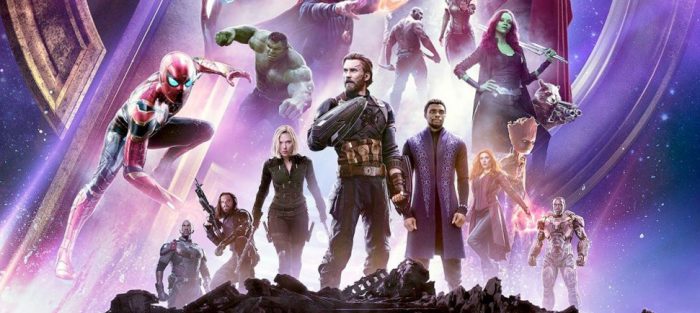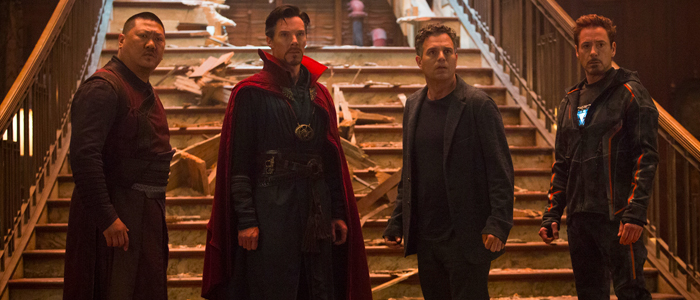‘Avengers: Infinity War’ and the Joys and Frustrations of Marvel Crossovers
Avengers: Infinity War opens today, and with it comes the promise of an epic storyline that not only represents the biggest assemblage of Marvel Cinematic Universe characters in one viewing, but potentially some canvas-cleaning to up the stakes too. Any one of the key Avengers team members — Captain America, Iron Man and Thor, in particular — could be sacrificed in some dramatic storytelling fashion.
The avid Marvel comics reader will recognize much of this storyline as drawing from the 1991 “Infinity Gauntlet” arc, where mad god Thanos acquires the powerful Infinity gems (stones in the movies) and uses them to wipe out half the universe’s population in order to impress his muse, the Mistress Death, resulting in an all-hands-on-deck brawl between him and scores of Marvel superheroes ranging from Captain America to She-Hulk in an epic space battle.
The Marvel Crossover
Marvel’s crossovers have always been a mish-mash of success. There have been the high-water mark crossover events like “Inferno”; the odd-ball ones like 1989’s “Atlantis Attacks” which includes everything from reviving an age-old serpent god Set and a bridal troop consisting of Marvel superheroines to bear his children; to the more politically convoluted stories like 2006’s “Civil War.”
Marvel’s crossovers have often been done to dramatic high notes, some of those played for the sort of histrionics that speak to the inner child in its readership, like the 1980’s extravaganza of “Secret Wars” crossover series — see the Hulk balancing a mountain on his back! Doctor Doom gets a new face! Colossus finds (loses) love! Spider-Man gets a new uniform! — which often felt like an extended toy advertisement that provided a template on how to make your eventual action figures live out storylines. The Beyonder, an immature, powerful, arbitrary being who took the heroes to his own world to battle and scrap for their lives, felt like a great stand-in for a pre-teen to teen readership in both demographic and mindset, as a sort of wish fulfillment fantasy that many people could relate to if given the proper tools or toys to create their own stories.
Exploring Onslaught
Yet the one that the upcoming movie really brings to mind is 1996’s “Onslaught” storyline. It’s an X-Men centered crossover that had been brewing for a few years. Dating back to their earlier “Fatal Attraction” storyline event where Professor Xavier uses his mental powers to “cleanse” the mind of rival Magneto, Onslaught, a combination of both men’s personalities and powers, incubates inside of Xavier’s subconscious, slowly growing in power. When he finally emerges, he’s not only a (literal) reality-warping threat, he’s also the resolution of a major plot point.
For years, there had been a dangling plot thread in the X-Universe about a traitor in their midst, shown in a looping, broken video footage of Jean Grey — broken and battered from a battle — warily looking over her shoulder before an offscreen energy blast kills the scene. With the emergence of Onslaught though, at first appearing in a series of powerful glimpses and cameos with characters to vet how strong he is, there’s the extended mystery of who he is too, and it’s not until X-Men #54 that his true identity is revealed.
This is good stuff. It’s fun stuff. “Onslaught” gets a lot of flack for its outrageousness, and that’s fair; as the combination of the X-universe’s two most powerful characters, he’s too powerful for the X-Men to handle alone, and so the efforts of the Avengers, Fantastic Four and the Hulk all have to come to their aid as Onslaught’s tirade threatens New York (of course), but also all of reality. And the outcome of the battle against Onslaught results in a series of heroic sacrifices that was more of an editorial mandate, resulting in the very uneven “Heroes Reborn,” where a collection of the industry’s top creators, like fan favorites Jim Lee and Rob Liefeld, restarted titles like Iron Man, Avengers, Fantastic Four and Thor.
But that’s the stuff of corporate. What really draws me to the Onslaught storyline though is the familiar trope of trauma, part and parcel of every superhero origin story, turned on its head a bit here. As it goes for the X-Men and mutants in general in the Marvel Universe, their powers manifest themselves in times of distress — falling from an airplane; watching a childhood best friend get hit by a car; being imprisoned in rubble, etc. — sparking a truer expression of who they are.
That Onslaught, hellbent on revenge and darkness, comes from Xavier’s own inner psyche and is triggered by a series of traumatic events, was something of a novel approach to a character long established as reserved, reverend-like and an unflinching pacifist of sorts. As the rather tired comparison goes, Xavier was positioned as the saint-like, sanitized Martin Luther King Jr. to Magneto’s Malcolm X; opposing analogs not only in terms of ideology but emotion.
Allowing the Onslaught entity to come from Xavier’s mind and body was a refreshing take on an otherwise increasingly stagnant character at the time though; allowing Xavier to look not only imperfect, but unwound too. In its own way, Onslaught became a manifestation of Xavier’s fuller true self and is a reminder of our dark thoughts and desires. Onslaught has a lustful rage that’s an expression of some of Xavier’s deep held thoughts, disdains and wants about the people and world around him, and while the outcome is ultimately destructive for nearly everyone around him, the Onslaught exercise has the sneaky feeling of being almost therapeutic for the character. He’s not just an evil manifestation; he’s a cathartic exercise for a man steeped not only his own trauma, but those around him that he’s absorbed, too.
The storyline is a metaphorical exercise in this. There’s the histrionics of Onslaught’s power — a requisite vetting of his power is the eventual appearance of the Watcher, Marvel’s observant entity on reality-shaping, historic moments in the Marvel Universe — but there’s also the plumbing of Xavier’s depths in a way that’s dramatic but also serves as some great commentary on relationships, emotions and power dynamics. Tossing his estranged half-brother, the all-powerful Juggernaut, harboring secret love and exhaustion about his students, Xavier’s inner- dialogue is the most compelling aspects of the early part of the Onslaught storyline. The writers have fun here with these character moments like the ones captured in X-Men #334, where the darker side of Xavier is on display to his students and there’s an increasing discomfort and tension as he becomes unfiltered.
“Onslaught” has more of these therapeutic moments draped in metaphor. As the entity becomes more and more unleashed (there’s a great dramatic reveal of his shared relationship with Xavier) the rest of the Marvel heroes get pulled in as Onslaught eventually houses Franklin Richards inside of his armored body. Forced to share the space with Charles Xavier, the two feel like their own extended commentary on not only comics — an industry that wrestles with defensiveness that comes with childlike stories increasingly told to adults — but with the constant ways that many adults try to come to grips with their inner selves, too; making peace with the child you were and the adult you’ve become.
And in that, the resolution of the story — where many of the company’s trademark characters sacrifice themselves to an abyss, only to be reborn again, is yes, heavy-handed. But it is also an apt commentary about the way that we struggle to let go of the stories that we see themselves in.
The Thrills (and Fatigue) of a Crossover
Avengers: Infinity War is playing now, and it’s highly unlikely that we’ll get anything that resembles the emotional complexity and nuance that their serial counterparts do in their panel pages. Some of this is the obvious mechanics of the industry itself; War is a major blockbuster movie; the sort that requires it keep an eye on balancing actor contracts and cameos as much as does the fate of the universe. Like its comic counterpart, Infinity War will likely have some dramatic deaths in the heat of battle – but it’s just as likely that some of those deaths will be reversed via the magic of storytelling and power gauntlets.
That means that the two-part finale that signals the end of one era of the Marvel Cinematic Universe will have the tough task of artfully (and perhaps artificially) extending the impact of this story; something that it has likely learned and borrowed from the comics themselves. In that respect, Infinity War might actually inspire event fatigue, something that comic book readers have lamented in the publishing world. “Event fatigue”, the feeling that there’s an endless deluge of “earth-shattering” crossover stories that will “upset the status quo” of an established world/universe, has been a discussion in the comics world for about a decade after a deluge of event stories crowded the readers’ experience in a seemingly endless fashion.
The effect wasn’t just an expensive experience – prodding people to follow stories that spanned across titles – but intrusive (encroaching into titles that often felt like they were editorially contorted to participate) and unstable, with characters dying, returning, changing teams, changing uniforms, altering personalities, changing moral codes, inheriting titles or losing them. Some of that, or depending on who you ask, much of that, lessened the value of the comic book investment that fans feel they’d made over time as the constant storylines and shifting positions often undid – and then returned – the familiar rhythm and tropes that had become calling cards of the X-Men, Captain America, Spider-Man and their peers. Infinity War doesn’t have this same baggage to bring to it; it’s more likely audiences will come just to see how all this shit fits together and who exactly will indeed die under the weight of saving the galaxy.
There will be a lot of fun seeing the toys brought together out of their various toy chests and mingle with each other; blending these worlds together feels like a triumph for Marvel fully realizing their panel realities on the big screen in the sort of braggadocio that feels like a constant trilling by Stan Lee (“SEE SPIDER-MAN, BLACK PANTHER AND CAPTAIN AMERICA TEAM-UP TO SAVE REALITY!”). But getting to those narrative and fan service highs and lows can test an audience’s patience when the stakes are played to this volume. We want much and expect a lot for and out of our heroes, and nowadays in particular, we want to believe that there’s people out there that want to march us into the light of a better tomorrow.
Much like Onslaught’s storyline, there’ll be something powerful about watching familiar heroes stride into the abyss, hoping to be reborn again on the other side. All stories should be so lucky.
The post ‘Avengers: Infinity War’ and the Joys and Frustrations of Marvel Crossovers appeared first on /Film.
from /Film https://ift.tt/2vRg8Nl




No comments: